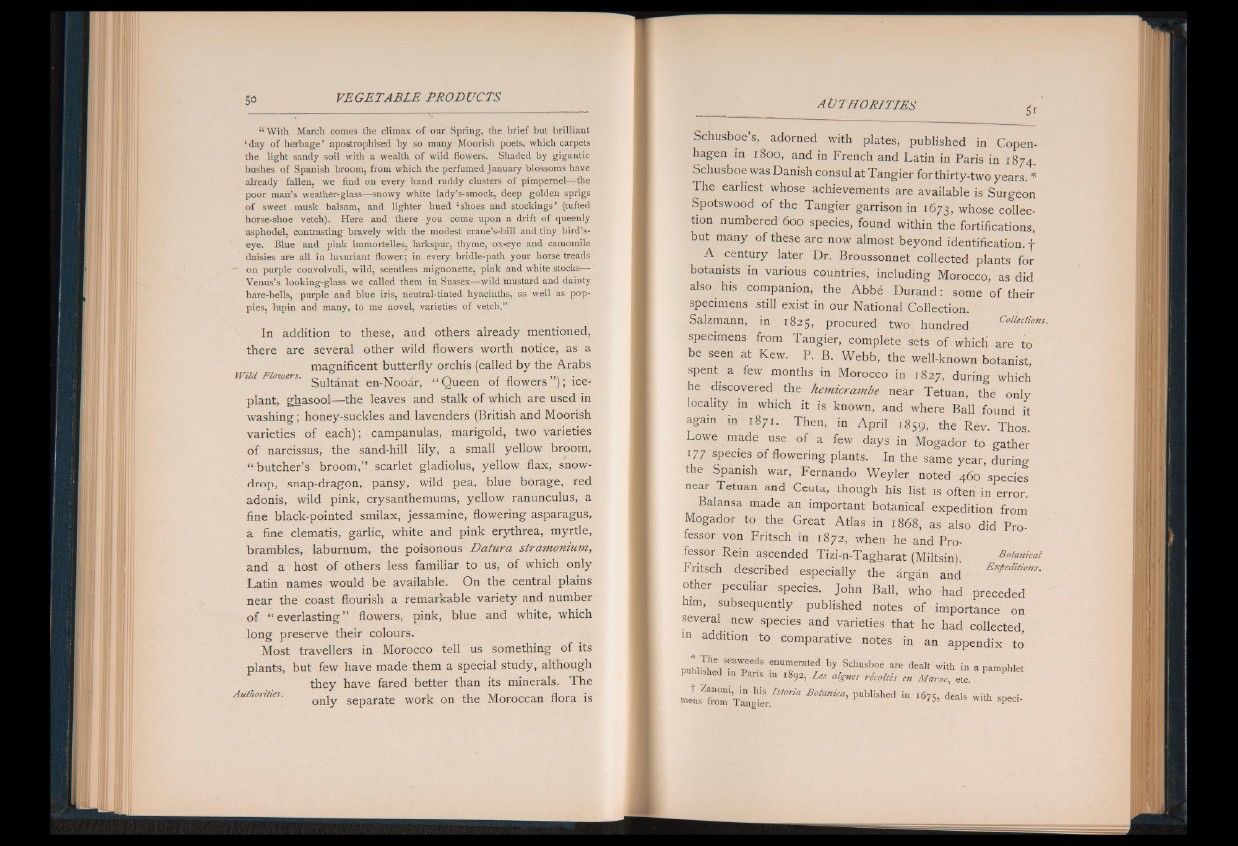
“ With March comes the climax of our Spring, the brief but brilliant
‘ day of herbage’ apostrophised by so many Moorish poets, which carpets
the light sandy soil with a wealth of wild flowers. Shaded by gigantic
bushes of Spanish broom, from which the perfumed January blossoms have
already fallen, we find on every hand ruddy clusters of pimpernel— the
poor man’s weather-glass— snowy white lady’s-smock, deep golden sprigs
of sweet musk balsam, and lighter hued ‘ shoes and stockings’ (tufted
horse-shoe vetch). Here and there you come upon a drift of queenly
asphodel, contrasting bravely with the modest crane’s-bill and tiny bird’s-
eye. Blue and pink immortelles, larkspur, thyme, ox-eye and camomile
daisies are all in luxuriant flower; in every bridle-path your horse treads
~ on purple convolvuli, wild, scentless mignonette, pink and white stocks—
Venus’s looking-glass we called them in Sussex— wild mustard and dainty
hare-bells, purple and blue iris, neutral-tinted hyacinths, as well as poppies,
lupin and many, to me novel, varieties of vetch.”
In addition to these, and others already mentioned,
there are several other wild flowers worth notice, as a
magnificent butterfly orchis (called by the Arabs
Wild Flowers. g u}t £n a t en_N00£rj “ Queen of flowers” ); iceplant,
ghasool— the leaves and stalk of which are used in
washing; honey-suckles and lavenders (British and Moorish
varieties of each); campanulas, marigold, two varieties
of narcissus, the sand-hill lily, a small yellow broom,
“ butcher’s broom,” scarlet gladiolus, yellow flax, snowdrop,
snap-dragon, pansy, wild pea, blue borage, red
adonis, wild pink, crysanthemums, yellow ranunculus, a
fine black-pointed smilax, jessamine, flowering asparagus,
a fine clematis, garlic, white and pink erythrea, myrtle,
brambles, laburnum, the poisonous Datura stramonium,
and a host of others less familiar to us, of which only
Latin names would be available. On the central plains
near the coast flourish a remarkable variety and number
of “ everlasting ” flowers, pink, blue and white, which
long preserve their colours.
Most travellers in Morocco tell us something of its
plants, but few have made them a special study, although
they have fared better than its minerals. The
only separate work on the Moroccan flora is
Schusboe’s, adorned with plates, published in Copenhagen
in 1800, and in French and Latin in Paris in 1874.
Schusboe was Danish consul at Tangier for thirty-two years. *
The earliest whose achievements are available is Surgeon
Spotswood o f the Tangier garrison in 1673, whose collection
numbered 600 species, found within the fortifications,
but many of these are now almost beyond identification, f
A century later Dr. Broussonnet collected plants for
botanists in various countries, including Morocco, as did
also his companion, the Abbé Durand : some of their
specimens still exist in our National Collection.
Salzmann, in 1825, procured two hundred Collections.
specimens from Tangier, complete sets o f which are to
be seen at Kew. P. B. Webb, the well-known botanist,
spent a few months in Morocco in 1827, during which
he discovered the hemicrambe near Tetuan, the only
locality in which it is known, and where Ball found it
again in 1871. Then, in April 1859, the Rev. Thos.
Lowe made use of a few days in Mogador to gather
177 species o f flowering plants. In the same year, during
the Spanish war, Fernando Weyler noted 460 species
near Tetuan and Ceuta, though his list is often in error.
Balansa made an important botanical expedition from
Mogador to the Great Atlas in 1868, as also did Professor
von Fritsch in 1872, when he and Professor
Rein ascended Tizi-n-Tagharat (Miltsin) Botanical
Fritsch described especially the ârgân and B B T '
other peculiar species. John Ball, who had preceded
him, subsequently published notes of importance on
several new species and varieties that he had collected,
in addition to comparative notes in an appendix to
publJÎedSi„aT dS “ " “ f by Schusboe are dealt with in a pamphlet
published in Pans m 1892, Les algues récoltés en Maroc, etc.
Published >675, deals with speci